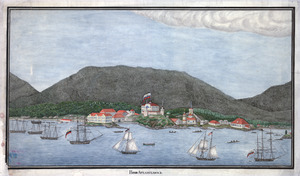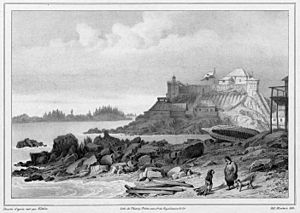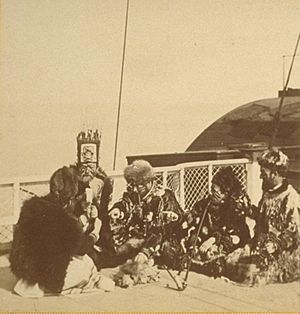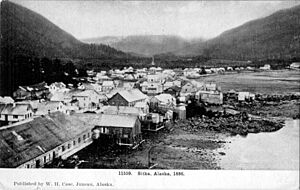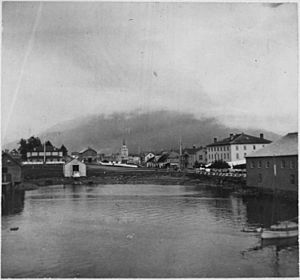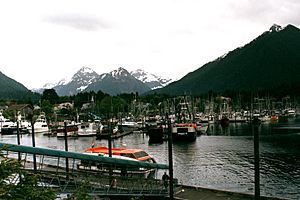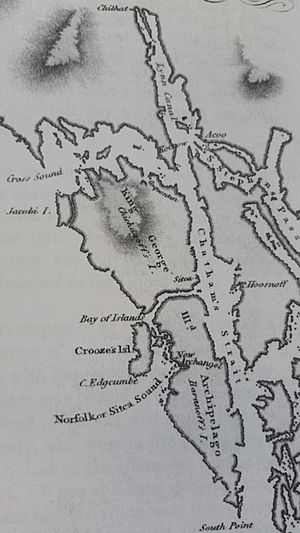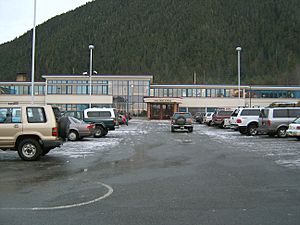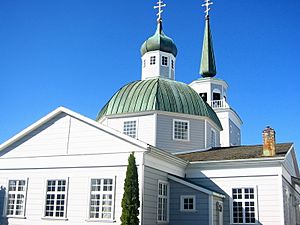Sitka, Alaska facts for kids
Quick facts for kids
Sitka
|
|||
|---|---|---|---|
|
Consolidated city-borough
|
|||
| City and Borough of Sitka | |||
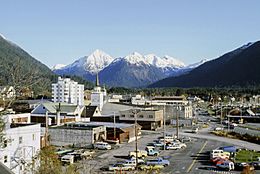
Downtown Sitka in 1984
|
|||
|
|||
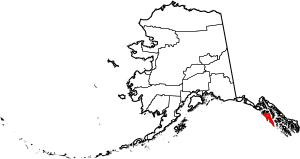 |
|||
| Country | |||
| State | |||
| Colonized | 1799, 1804 | ||
| Incorporated | November 5, 1913 (city) September 24, 1963 (borough) December 2, 1971 (unified municipality) |
||
| Named for | Tlingit for "People on the outside of Shee" | ||
| Area | |||
| • Consolidated city-borough | 4,815.14 sq mi (12,471.16 km2) | ||
| • Land | 2,870.06 sq mi (7,433.42 km2) | ||
| • Water | 1,945.09 sq mi (5,037.75 km2) | ||
| • Urban | 2 sq mi (5 km2) | ||
| Elevation | 26 ft (8 m) | ||
| Population
(2020)
|
|||
| • Consolidated city-borough | 8,458 | ||
| • Estimate
(2022)
|
8,382 |
||
| • Density | 2.95/sq mi (1.14/km2) | ||
| • Urban | 7,668 | ||
| Time zone | UTC-9 (Alaska (AKST)) | ||
| • Summer (DST) | UTC-8 (AKDT) | ||
| ZIP Code |
99835
|
||
| Area code | 907 | ||
| FIPS code | 02-70540 | ||
| GNIS feature ID | 1414736 | ||
Sitka (Tlingit: Sheetʼká; Russian: Ситка) is a city in the southeast part of Alaska, a state in the United States. It was once under Russian rule from 1799 to 1867. Sitka is located on the west side of Baranof Island and the southern part of Chichagof Island. These islands are in the Alexander Archipelago of the Pacific Ocean.
In 2020, Sitka had a population of 8,458 people. This makes it the fifth-most populated city in Alaska. Sitka is also the largest city in the U.S. by total area. This includes both land and water. Its total area is about 4,811 square miles (12,461 square kilometers).
Contents
History of Sitka
When Sitka was part of Russia, it was called New Archangel (Russian: Ново-Архангельск). The name Sitka comes from the Tlingit words Sheetʼká. This means "People on the Outside of Baranof Island."
Early Russian Settlement
Russian explorers first settled in Old Sitka in 1799. They named it Fort of Archangel Michael. Alexander Baranov, the governor of Russian America, led this settlement. He worked for the Russian-American Company, a trading company.
In June 1802, Tlingit warriors attacked the settlement. They destroyed it and killed many Russians. Only a few managed to escape. Baranov had to pay a large amount of money to a British ship captain to get the remaining settlers back safely.
Baranov returned to Sitka in August 1804 with a strong force. His ship, the Neva, bombed the Tlingit fort. The Russians then attacked the fort but were pushed back. After two more days of bombing, the Tlingit left their fort.
After this victory in October 1804, the Russians built a new settlement called "New Archangel." It was named after a city in Russia. New Archangel became the biggest city in the area. In 1808, Sitka became the capital of Russian America.
Churches in Sitka
Bishop Innocent lived in Sitka after 1840. He cared a lot about education. His house, the Russian Bishop's House, was partly used as a school. Today, it is a restored historical site.
The first Cathedral of Saint Michael was built in Sitka in 1848. It was the main church for the Russian Orthodox bishop. In 1966, the original church burned down. It lost many valuable items, including handmade bells and old books. The church was later rebuilt to look like the original.
Many people from Sweden, Finland, and other countries worked for the Russian-American Company. They were Lutherans, which led to the first Protestant church on the Pacific coast. The Sitka Lutheran Church was built in 1840. After Alaska became part of the U.S. in 1867, more Protestant churches grew. Saint-Peter's-by-the-Sea Episcopal Church was built in 1900.
Alaska Becomes Part of the U.S.
Sitka was where the Alaska purchase ceremony happened on October 18, 1867. Russia decided to sell Alaska because it had financial problems after losing a war. They offered to sell it to the United States.
William Seward, the U.S. Secretary of State, wanted to buy Alaska. He believed it was important for America to reach the Pacific Ocean. The U.S. bought Alaska for $7.2 million, which was about 2 cents per acre.
Sitka was the capital of Alaska under U.S. rule from 1867 to 1906. The government moved the capital to Juneau in 1906. This was because Juneau grew more important during the Klondike Gold Rush.
Alaska Native Brotherhood
The Alaska Native Brotherhood was started in Sitka in 1912. Its goal was to fight against racism faced by Alaska Native people. By 1914, they built their own hall on Katlian Street. This street was named after a Tlingit war chief.
Sitka During World War II
In 1937, the U.S. Navy built a seaplane base on Japonski Island. This island is across the Sitka Channel from the town. In 1941, they started building Fort Ray, an army base. This base was to protect the naval air station. Both the army and navy stayed in Sitka until the end of World War II.
Economy of Sitka
Sitka's economy has changed over time. In the past, gold mining and fish canning were very important.
Today, Sitka includes parts of Baranof Island and the smaller Japonski Island. The John O'Connell Bridge connects Japonski Island to Baranof Island. This bridge was the first cable-stayed bridge built in the Western Hemisphere.
Japonski Island is home to important places. These include Sitka Rocky Gutierrez Airport, the University of Alaska Southeast campus, and Mt. Edgecumbe High School. It also has a hospital and a U.S. Coast Guard air station.
The seafood industry is a big part of Sitka's economy. Many people earn money from fishing and processing seafood. Sitkans also gather foods like fish, deer, berries, and seaweed for themselves.
Sitka gets its electricity from dams at Blue Lake and Green Lake. In 2014, the Blue Lake Expansion project was finished. This project added 27 percent more electricity for the city.
Sitka's Port
Sitka has the sixth largest port in the U.S. for the value of seafood caught. It also has the largest harbor system in Alaska, with many places for boats to dock.
During Russian rule, Sitka was a very busy seaport. Today, many cruise ships visit Sitka. Most of them dock at the Old Sitka Dock. This dock is a private deep-water port. In 2017, over 150,000 cruise ship passengers visited Sitka.
Geography and Climate
Sitka is the largest incorporated city by area in the U.S.. Its total area is about 4,811 square miles (12,461 square kilometers). About 40% of this area is water. To compare, Sitka is almost four times the size of the state of Rhode Island.
Sitka's Climate
Sitka has an oceanic climate. This means it has moderate, cool temperatures and a lot of rain. The average yearly rainfall is about 131.74 inches (334.6 cm). The average yearly snowfall is about 33 inches (84 cm).
The weather in Sitka is quite mild compared to other parts of Alaska. This is because it is close to the ocean. Only about 5 days a year have temperatures above 70°F (21°C). Also, there are only about 10 days a year when the temperature stays below freezing.
The highest temperature ever recorded in Sitka was 88°F (31°C) in July 1976 and July 2020. The lowest temperature ever recorded was -1°F (-18°C) in February 1948.
Mount Edgecumbe Volcano
Mount Edgecumbe is a volcano located about 15 miles (24 km) west of Sitka. It is 3,200 feet (975 meters) tall. On a clear day, you can see it from the city.
In April 2022, scientists noticed a lot of small earthquakes near Mount Edgecumbe. They also saw that the ground around the volcano had been rising since 2018. This means that new magma (melted rock) is moving under the volcano. It is about 3 miles (5 km) below the surface.
It is important to know that magma moving under a volcano does not always mean an eruption will happen. But if the magma moves closer to the surface, there would be more earthquakes and ground changes. This would give a warning before any eruption.
Nearby Areas and Parks
- Hoonah-Angoon Census Area, Alaska – to the north and northeast
- Prince of Wales–Hyder Census Area, Alaska – to the southeast
Sitka is also near several protected natural areas:
Population of Sitka
| Historical population | |||
|---|---|---|---|
| Census | Pop. | %± | |
| 1880 | 916 | — | |
| 1890 | 1,190 | 29.9% | |
| 1900 | 1,396 | 17.3% | |
| 1910 | 1,039 | −25.6% | |
| 1920 | 1,175 | 13.1% | |
| 1930 | 1,056 | −10.1% | |
| 1940 | 1,987 | 88.2% | |
| 1950 | 1,985 | −0.1% | |
| 1960 | 3,237 | 63.1% | |
| 1970 | 3,370 | 4.1% | |
| 1980 | 7,803 | 131.5% | |
| 1990 | 8,588 | 10.1% | |
| 2000 | 8,835 | 2.9% | |
| 2010 | 8,881 | 0.5% | |
| 2020 | 8,458 | −4.8% | |
| 2023 (est.) | 8,282 | −6.7% | |
| U.S. Decennial Census 2010-2020 |
|||
Sitka first appeared in the U.S. census in 1880. At that time, it had 916 residents. Most of them were Tlingit people. In 1890, Sitka was the second largest community in Alaska, after Juneau.
Over the years, Sitka's population has changed. In 1913, Sitka officially became a city. By 1960, for the first time, most of Sitka's residents were White. In 2010, Sitka had 8,881 people. About 64.6% were White, and 24.6% were Native American.
Education in Sitka
Colleges and Universities
Sitka has one college, the University of Alaska Southeast-Sitka Campus. It is located on Japonski Island. Sheldon Jackson College, a private college, closed in 2007. A new college, Outer Coast College, is being developed on its old campus.
Schools in Sitka
The Sitka School District runs several public schools. These include Sitka High School and Pacific High School. It also has Blatchley Middle School, the town's only middle school.
Mt. Edgecumbe High School is a special boarding high school. It is run by the State of Alaska for students from rural areas, especially Native students. It is also on Japonski Island.
Sitka also has one private school, Sitka Adventist School.
Alaska State Trooper Academy
The Alaska State Trooper Academy is located in Sitka. This is where all Alaska State Troopers are trained.
Libraries
Sitka Public Library is the public library for Sitka. It has about 75,000 books and other materials. Many visitors enjoy the library's view of the Eastern Channel and the Pyramids mountains.
Media in Sitka
Newspapers
Sitka has its own daily newspaper, the Daily Sitka Sentinel. It is one of the few independent daily newspapers in Alaska. Sitka also receives the Capital City Weekly, a regional newspaper from Juneau.
Alaska's first newspaper after the U.S. purchase was the Sitka Times. It started in Sitka in 1868.
Radio and Television
Sitka has three radio stations: KCAW (public radio), KIFW, and KSBZ (commercial radio).
KTNL-TV (MeTV) broadcasts from Sitka on Channel 13. Other TV channels like KTOO (PBS) and KJUD (ABC/CW) also serve the area.
Getting Around Sitka
Transportation Options
Sitka is on islands, so you can only reach it by boat or plane. Cars are usually brought to Sitka by the Alaska Marine Highway ferry system. However, you don't always need a car in Sitka. There are only about 14 miles (22 km) of roads. Most places are close enough to walk to from downtown. Public buses are also available.
For air travel, Sitka Rocky Gutierrez Airport has flights from Alaska Airlines and Delta Connection. The airport is on Japonski Island, connected by the John O'Connell Bridge. Sometimes, flights are delayed in fall and winter due to Sitka's weather. The Sitka Seaplane Base is also nearby for seaplanes.
You can travel to Juneau, Ketchikan, and other towns by ferry using the Alaska Marine Highway System. The ferry terminal is about 7 miles (11 km) north of downtown.
Sitka is a very bike-friendly and walk-friendly community. In 2008, it was named the first bicycle-friendly community in Alaska. In 2013, it also became the first Alaska community with a Walk Friendly Communities award.
Healthcare
Sitka has one hospital, Edgecumbe Hospital, on Japonski Island. It is part of the Southeast Alaska Regional Health Consortium (SEARHC). This hospital serves as a main medical center for people across Southeast Alaska. It offers many specialized clinics. The former Sitka Community Hospital is now a long-term care facility.
Famous People from Sitka
- Dale DeArmond (1914–2006), a famous printmaker and book illustrator.
- Richard Nelson (1941–2019), a cultural anthropologist and writer.
- Teri Rofkar (1956–2016), a Tlingit weaver known for her beautiful baskets.
- John Straley (born 1953), an award-winning author.
Sister City
Sitka has one sister city:
 Nemuro, Hokkaido, Japan
Nemuro, Hokkaido, Japan
Fun Things to See and Do in Sitka

Sitka has many interesting places to visit:
- Alaska Raptor Center: A place that helps injured birds of prey.
- Baranof Castle Hill: A historic site where the Alaska purchase ceremony happened.
- Fortress of the Bear: A rescue center for orphaned brown bears.
- Russian Bishop's House: A historic Russian Orthodox building.
- St. Michael's Cathedral: A beautiful Russian Orthodox church.
- Sheldon Jackson Museum: A museum with Alaska Native art and cultural items.
- Sitka Fine Arts Camp: A summer camp for young artists.
- Sitka Historical Museum: Learn about Sitka's past.
- Sitka National Historical Park: A park with Tlingit totem poles and Russian history.
- Sitka Pioneer Home: A historic home for older Alaskans.
- Sitka Summer Music Festival: A festival with classical music performances.
- Tongass National Forest: A huge national forest with beautiful nature.
You can also enjoy day cruises and guided hikes to see Sitka's amazing plants and animals. Floatplane tours offer great views from above.
Outdoor Adventures
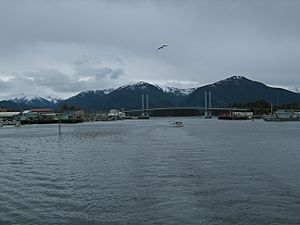
Sitka is great for outdoor activities because it's between the Pacific Ocean and mountains.
- Kayaking is very popular, and you can take guided trips.
- There are many hiking trails around Sitka.
- You can even hike up the dormant volcano, Mount Edgecumbe. It's a 7-mile (11 km) trail to the top.
See also
 In Spanish: Sitka para niños
In Spanish: Sitka para niños





